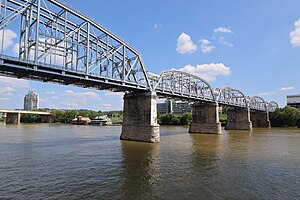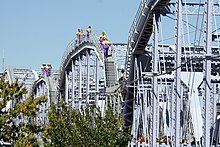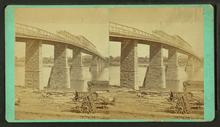Purple People Bridge
Newport Southbank Bridge | |
|---|---|
 The bridge viewed from the river in 2022 | |
| Coordinates | 39°05′53″N 84°29′52″W / 39.098019°N 84.497747°W |
| Carries | pedestrians |
| Crosses | Ohio River |
| Locale | Newport, Kentucky and Cincinnati, Ohio |
| Other name(s) | Purple People Bridge |
| Characteristics | |
| Design | Truss bridge |
| Total length | 2,670 feet (810 m) |
Newport and Cincinnati Bridge | |
| Location | Spans Ohio River, Cincinnati, Ohio |
| Built | 1868–1872 |
| Architect | Becker, M.J.; et al. |
| Architectural style | Subdivided Pratt truss |
| NRHP reference No. | 01000364[1] |
| Added to NRHP | April 17, 2001 |
| History | |
| Opened |
|
| Location | |
 | |


The Purple People Bridge is a pedestrian-only bridge that stretches 2,670 feet over the Ohio River, connecting Newport, Kentucky to downtown Cincinnati, Ohio.
History
[edit]The original bridge first opened on April 1, 1872, under the name Newport and Cincinnati Bridge, and was Cincinnati's first railroad bridge spanning the Ohio River.[2] The bridge piers were built with stone from Adams County, Ohio.[3]
In 1896, a major reconstruction for the bridge was started. It involved constructing two new streetcar and a carriage deck, with the latter being partially cantilevered. This work also rebuilt the existing railroad deck into a Pennsylvania prat truss. This was completed in 1897, and done to modernize the bridge, despite only being 25 years old, it had already been rendered obsolete with the increased weight of trains.[4][5]
In 1904, the bridge was renamed the L&N (Louisville and Nashville) Railroad Bridge. Following this, the road deck was paved with asphalt to allow for improved usage.[4]
After the opening of the Dixie Terminal's lower level on November 27, 1921, the CN&C's streetcar tracks were reconfigured to cross the Central bridge, and the L&N Railroad Bridge was restricted to emergency use only.[4]
In 1928, the Kentucky Highway Department made plans to purchase the vehicular and streetcar sections of the Bridge. This transaction was met with resistance from the L&N Railroad since the tolls started to become profitable with an increase in automobile traffic, however, when the city threatened to build a competing bridge nearby, a deal was reluctantly struck, and on November 15, 1935, these parts of the bridge were sold. On November 11, 1941, at 2 p.m, tolls were abolished from the crossing after the bonds for the purchase had been paid off. An hour later, a dedication of the now free bridge was held.[4]
On July 3, 1950, the bridges streetcar tracks was closed.[4] The west track was dismantled, and the east track was replaced by a pedestrian walkway.[6] [6]
In 1956, a loop ramp from 2nd Street was opened to traffic. Also around this time, the railroad tracks were converted to go in one direction at peak travel times in the mornings and evenings.[4]
In the 1960s, there were proposals to replace the bridge as part of construction of Interstate 471. This never occurred.[6]
In 1971, the Seaboard Coast Line Railroad (SCL) purchased the remainder of the L&N shares it did not already own, and the L&N became a subsidiary.[4]
In 1980, the road and pedestrian trusses were repainted, while road deck was replaced.[4]
SCL absorbed the L&N entirely in 1982 with the newly merged company known as Family Lines. At the end of June 1984, the bridge's tracks were abandoned. In 1986, the SCL formally merged with the Chessie System, which became CSX Transportation (CSX). At this point, work began on demolishing the rail approaches and removing the train deck, whitch was competed in 1987.[4]
By the 1990s, the bridge had become a lightly use automobile bridge. In addition, after the bridges rail tracks were removed, the CSX ceased maintenance of them resulting in a notable rust, this was well the feast of the crossing was still maintained. In 2000, the Newport approach was partially demolished with the opening of a new parking garage next to it.[6] In October 2001, after years of neglect, the vehicular deck was closed. At this point, the city of Newport, Kentucky, and Southbank Partners, a regional economic development organization, used $4 million in state funds to restore the bridge and convert the deck into a pedestrian one. When it was time to decide on what color to paint it, a variety of options were explored. Computer-generated images of the bridge were shown to participants in more than a dozen focus groups, all of whom picked the color purple as a top choice. It was soon nicknamed the "Purple People Bridge" by area residents. This project was completed in May 2003. Since this rehab the bridge has been maintained by The Purple People Bridge Company, which maintains public access for pedestrian and bicycle traffic.
In 2006, it became possible for the public to cross the bridge via its superstructure, though only while wearing appropriate safety gear. There are similar bridge climb experiences in Australia and New Zealand. Citing lack of funds and low attendance, the Purple People Bridge Climb was discontinued on May 23, 2007.[7]
In 2012, the purple people bridge company announced they were considering building retail space on the bridge in order to fund work on it. However, they acknowledged that it might not be possible, as such, an engineer would have to see if it was or would need a retrofit to do such.[4]
The bridge was repainted in 2017.[8]
In 2022, as part of the bridges 150th anniversary, various events were held. One of these was renaming the Newport Southbank Bridge as the Purple People Bridge, its popular nickname.
In 2024, the bridge was closed after parts of its pier fell off. Nobody was killed or injured in the accident.[9]
Gallery
[edit]-
Deck of the bridge
-
Underside viewed from the river
-
The bridge as viewed from the Carew Tower observation deck
See also
[edit]References
[edit]- ^ "National Register Information System". National Register of Historic Places. National Park Service. November 2, 2013.
- ^ Sonnenberg, Elissa (2006). "Purple People Greeter". Cincinnati Magazine. Cincinnati USA: 2006 City Guide. p. 14. Retrieved May 6, 2013.
- ^ Evans, Nelson Wiley (1900). A History of Adams County, Ohio: From Its Earliest Settlement to the Present Time. E B. Stivers. pp. 427.
- ^ a b c d e f g h i j "Purple People Bridge". July 16, 2023.
- ^ "History". The Purple People Bridge, Newport Southbank Bridge Company. Retrieved June 30, 2018.
- ^ a b c d "L&N Bridge".
- ^ Demeropolis, Tom (October 19, 2012). "Purple People Bridge would be 'international attraction'". Cincinnati Business Courier. Retrieved December 16, 2013.
- ^ https://www.wcpo.com/news/insider/purple-people-bridge-will-soon-have-more-pop-with-1m-paint-job-to-restore-its-vibrancy#google_vignette
- ^ "What's next for the Purple People Bridge? Company says funds are needed to fix, maintain it". May 21, 2024.
External links
[edit]- Official website
- Early bridge photograph circa 1910 from the Cincinnati Memory project
- L&N Cincinnati-Newport Railroad Bridge Archived March 25, 2012, at the Wayback Machine at BridgeHunter
- Bridges completed in 1872
- Railroad bridges on the National Register of Historic Places in Kentucky
- Railroad bridges on the National Register of Historic Places in Ohio
- Road bridges on the National Register of Historic Places in Kentucky
- Road bridges on the National Register of Historic Places in Ohio
- Bridges in Cincinnati
- Louisville and Nashville Railroad
- Newport, Kentucky
- Bridges over the Ohio River
- National Register of Historic Places in Campbell County, Kentucky
- National Register of Historic Places in Cincinnati
- Truss bridges in the United States
- Former road bridges in the United States
- Former railway bridges in the United States
- Road-rail bridges in the United States
- Pedestrian bridges in Kentucky
- Pedestrian bridges in Ohio
- Transportation in Campbell County, Kentucky
- Rail trail bridges in the United States
- Rail trails in Kentucky
- Rail trails in Ohio
- 1872 establishments in Ohio
- 1872 establishments in Kentucky
- 1897 establishments in Ohio
- 1897 establishments in Kentucky




